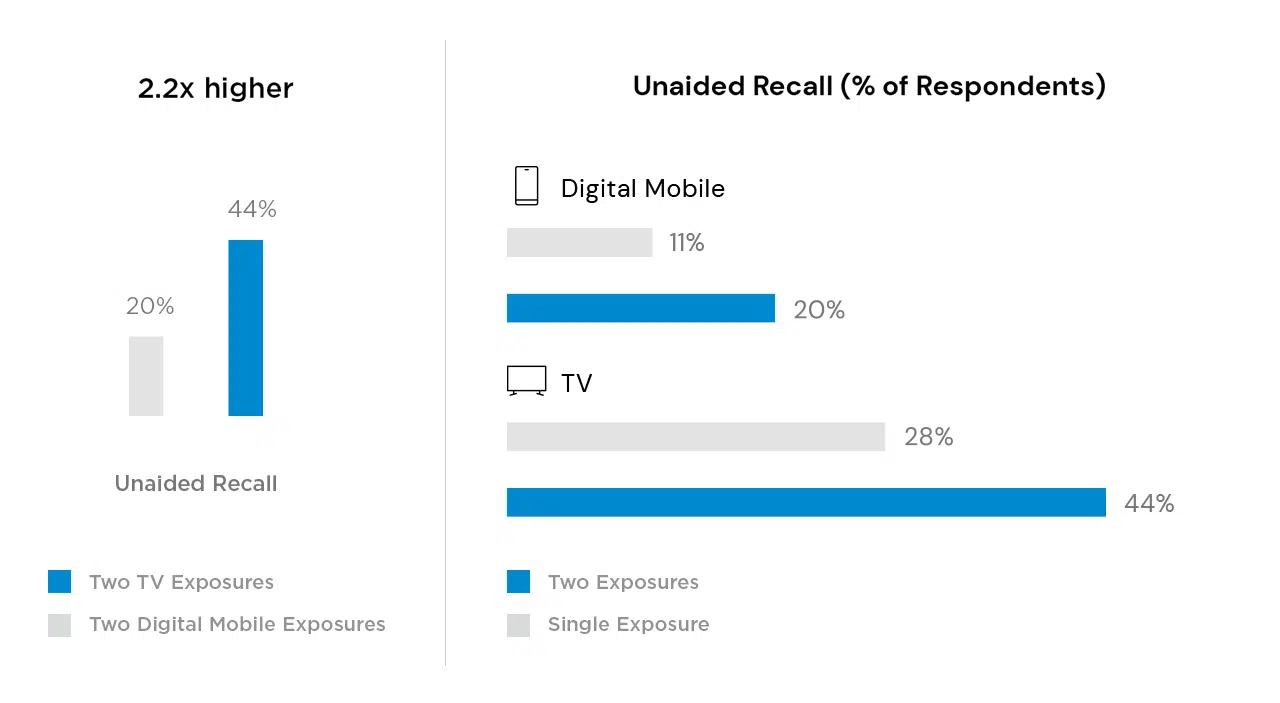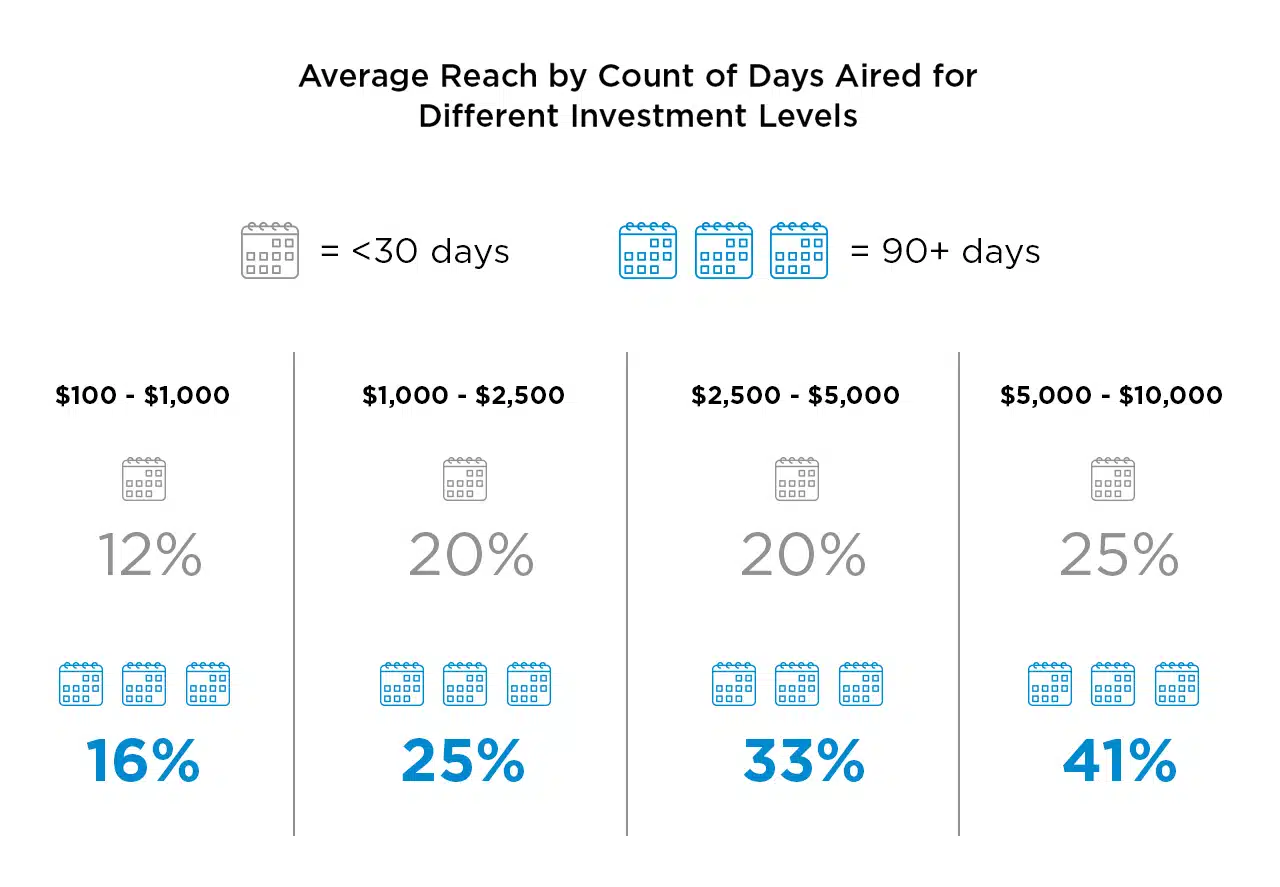When it comes to brand marketing, there’s no substitute for the power of consistency. Consistent brand awareness through a long-term, strategic advertising approach supports all phases of the marketing funnel, helping to positively impact the growth of your business.
Here’s how a consistent multiscreen TV advertising approach can help maximize your audience reach and keep your brand top of mind when customers are ready to make a purchase:
Increase Brand Recognition on the Big Screen
An always-on multiscreen TV advertising strategy can lead to greater sustained brand success by not only elevating overall brand awareness, but also increasing brand trust, credibility, and memorability. Insights from Comcast Advertising’s TV Makes Memories report suggests that ads viewed in a TV environment have a unique ability to drive engagement and build memories; this can be attributed to three factors of engagement that are important for branding and driving outcomes: attention, emotion, and repetition.
The report studies how different types of ad exposures impact memory by testing a digital environment, with and against a TV environment. The digital environment consisted of either short-form YouTube clips or feed-based Facebook advertising (both on a mobile device), while the TV environment consisted of either traditional TV or connected TV (CTV) programming on a large screen. The study reveals that ads viewed in the TV environment had 2.2x greater unaided recall than ads viewed in a mobile environment – proving the effectiveness of building memories through premium long-form TV advertising on the big screen.1
Here’s where the power of consistency comes into play: unaided brand recall increased from a single exposure to a second exposure for the TV viewing experience by 16%. This resulted in 44% of respondents being able to recall the brand (without any external help such as clues or visuals) just after two ad exposures on a TV screen.1
TV Content Can Outperform User-Generated Content (UGC)
Another study highlighted within The Comcast Advertising Report, showcased how TV content outperformed user-generated content (UGC) across all age groups. The study compared AVOD and FAST content against YouTube UGC – all tested on a TV screen. It was discovered that brand recall and recognition from the participants of the study were significantly higher for TV content when compared to UGC.
When analyzing data from the respondents (participants who viewed both UGC and TV content), there was +58% higher unaided recall reported for TV content compared to UGC, which is an indication of the ability for TV content to form and reinforce memory structures within individuals.2 This further proves the length at which multiscreen TV advertising, including both traditional and streaming, can increase brand awareness and consideration.
Longer Campaign Flights Can Help Drive Reach and Results
Insights from Comcast’s aggregated viewership data demonstrate the power of longer flights for increased in-audience reach. The data suggests that the more days a commercial is on air, the higher audience reach you will garner (the more households that will see your ad) – and this holds true among all investment levels.
Whether your monthly advertising budget is $1,000 or $100,000, you’ll still maximize audience reach when your campaign runs for 90+ days vs. a shorter run time.3
Building your long-term TV advertising strategy with Comcast Advertising can allow you to maximize your audience reach and extend your brand exposure. An analysis of Comcast Advertising multiscreen TV advertising campaigns showed significant audience reach within 30 days of the start of a campaign. Reach and frequency continue to build every month after that, underscoring the importance of an always-on campaign.
Comcast Advertising advertisers garnered +5% additional multiscreen reach (number of households) and +1.2 additional multiscreen frequency (times per household) every month of their campaign after the first 30 days.4
Beyond reach and frequency, longer flight times can help increase conversions through website visits. If you’re a marketer, you’re likely familiar with the marketing rule of seven. The rule states that consumers need to see information about a brand at least 7X before making a purchase and becoming a customer. If this rule holds true, then consistent advertising in a TV environment can be your next best strategy – but don’t just take our word for it, let’s look at the data:
Measuring the Continuous Impact of Multiscreen TV Campaigns
Many advertisers are challenged with the question, “What’s the point of advertising if you can’t measure your return on ad spend (ROAS)?” Comcast Advertising’s Multiscreen IMPACT is a multi-touch attribution solution that allows advertisers to see the comprehensive, multiscreen measurement of viewer response following all Comcast Advertising campaigns, TV and Streaming. With Comcast’s aggregated first-party data, Multiscreen IMPACT, through Comcast Advertising partner TVSquared, can measure KPIs (such as web visitations) influenced by cross-screen campaigns.
Website attribution data shows an evident correlation between impressions and website visits, meaning that a consistent strategy will help fill your sales funnel from top to bottom.5
With this data, Comcast Advertising also uncovered that the majority of responses from viewers come days (not minutes) after the advertisement is seen. The campaigns in the analysis uncovered that over 86% of total visits to the website happened 2-7 days after the advertisement aired, showcasing the lingering effect of TV advertising.6
Investing in long-term multiscreen TV advertising means you can build and strengthen your brand presence and maximize audience reach. With Comcast Advertising’s attribution reports, you can better understand the impact of your campaigns and how they are driving results for your business. It isn’t going to be an overnight process to achieve known brand status. Like many great things, it will take time – but by maintaining a consistent level of brand-building for your audience, you’ll get closer to the finish line.
Download the infographic to further understand the benefits of TV advertising for brand building.
Interested in learning more about how Comcast Advertising can help with your next multiscreen TV advertising campaign? Contact us.
Sources:
*Conversions are website visits as measured by TVSquared.
1. Media Science, Comcast Advertising Study, March 2022, n=188. Analysis compares two ads on digital, TV + digital ad, and two TV ads. TV comprises a traditional TV ad &/or a streaming TV ad. Digital comprises Facebook & YouTube on a mobile device.
2. Comcast Advertising, MediaScience study, May 2023. Recall tested in a series of survey questions post viewing, n=284.
3. Comcast Aggregated Viewership Data. Analysis of Jan-May 2022 campaigns, 14K+ campaigns. Total HHs.
4. Comcast Aggregated Viewership Data combined with Ad Exposure Data from TV + Streaming Premiere campaigns (Jan-Dec 2021). Total HHs.
5. Multi-Screen Impact Powered by TVSquared, 01/31/2022 – 02/28/2022. Comcast analysis of advertiser campaign. Website visits are measured by TVSquared.
6. Multi-Screen Impact Powered by TVSquared, 2/1/22 – 1/31/23. Website visits are measured by TVSquared. Comcast Analysis of Advertiser Campaigns.








